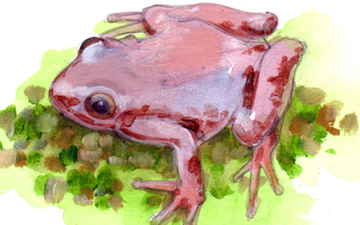The Mountain Chorus Frog (Pseudacris brachyphona) is a species of frog in the Hylidae family. It is endemic to the United States. Its natural habitats are temperate forests, rivers, intermittent rivers, swamps, freshwater marshes, intermittent freshwater marches, freshwater springs, ponds, open excavations, and canals and ditches. It is threatened by habitat loss. The Mountain chorus frog is a small frog, but an intermediate size for the Genus of Pseudacris. It consists of different shades of grey or brown, including sorghum brown, deep brownish drab, or mars brown. They are stocky in the body and broader in the head, which is very close to the structure and size of Hyla femoralis or commonly known as a Pine Woods tree frog. The adult frog grows anywhere from 1-1 3/8 inches. The males are usually between 24-32 mm and the females are 27-34 mm. The Mountain Chorus frog has a unique triangle between the eyes and a white line on the upper lip. Something that is unique in the male is that they have a dark throat.
The Mountain Chorus frog has a unique call. It is a faster, higher note, and holds a distinct quality and form. The repetitions are quicker and the pitch higher. When a whole chorus of them are heard, you can tell them apart from other groups. The Mountain Chorus Frog’s call has a rate of 50 to 70 times a minute and can be continued for several minutes, though they usually stop in fifteen to twenty seconds. This distinct call is rapid and can be heard on a clear night up to a quarter mile away (Wright, 230/231). Their voice has a bit of a nasal quality to it and sounds like a wagon wheel turning that needs oil. It is a harsh, raspy “wreeck” or “reek” sound.
(From Wikipedia.org, October 13 2010)
– – –
This frog has a stocky body, long legs and prominent tarsal pads. Adults reach a body length of 35 mm. Dorsal coloration varies from light brown or grey to olive-grey. The venter is paler. A distinct white stripe runs from the upper lip to the tympanum. Dark lateral and paramedian stripes are well defined and extend onto the tibiae and femora when the legs are flexed. There is a suffusion of bright yellow on the undersides of the hind legs.
(From AmphibiaWeb via The Encyclopedia of Life, October 13 2010)




